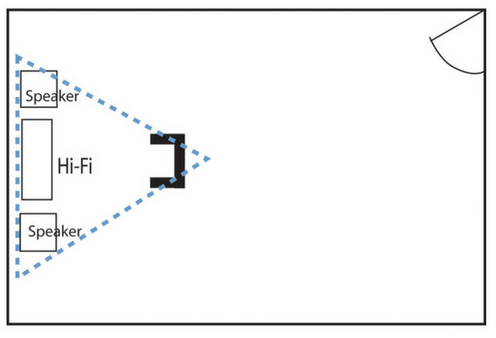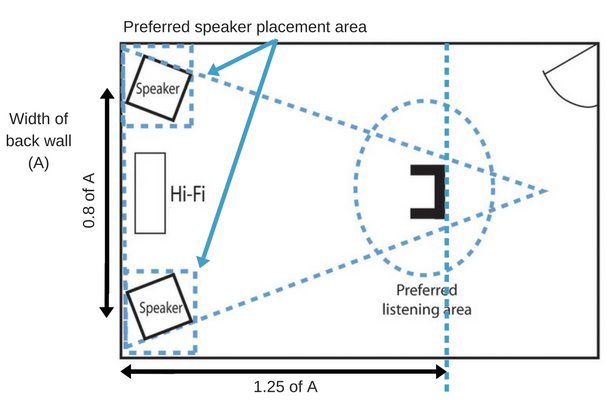
2. System Placement
Here, I will deal in detail with the room and what you can do to minimise the effects of feedback and get the best sound of which your system and room are capable. System and loudspeaker placement is critical but a great deal of misinformation is given by 'experts' and Hi-Fi magazines. The two most common misconceptions are to keep your speakers well away from walls and to put them close together to avoid the so called 'hole in the middle'.
Myth 1: Keep your speakers away from walls
The exact position for a loudspeaker in your room will depend on the design and size of the loudspeaker and on the shape of your room. Some designs need to be very close to the wall, others need to be up to three feet from the back wall.
Large loudspeakers with big floppy bass units may react badly to being placed in corners and large Quad electrostatics will not give their best sound if used close to a back wall or in a small room. It is up to you to experiment within the guidelines I have indicated in 'Perfect Speaker Positioning' below. You cannot rely on the advice given by the loudspeaker manufacturer without testing it for yourself.
Myth 2: Put your speakers together to avoid a 'hole in the middle'
Most speaker manufacturers and magazines say that it is best to form an equilateral triangle between the speakers and your seating position.
They show a diagram like the one below that suggests that the speakers should be quite close together and you close to them. The result of this arrangement is a very small, intense and confused soundstage. This is as unsatisfactory and unconvincing as running a fancy Home Cinema system using a 14" TV set as the picture monitor!

Diagram 5.2: The 'ideal' set up, according to most speaker manufacturers and Hi-Fi magazines.
The advice in a popular Hi-Fi magazine that, "If the distance from you to each speaker is less than the distance between the speakers, the sonic 'picture' created will have a hole in the middle", is complete nonsense! It is absolutely impossible for a hole to appear in the middle. Think about it; if this were the case, headphones wouldn't work. What you are trying to achieve is the correct angular and depth perspectives of the sound sources.
Site your speakers as I suggest and it will open out the soundstage to the size of the back wall. It is much more realistic, the separation between instruments and performers is greater and the 3-dimensionality is very much deeper.
You will see from the illustration of my preferred speaker layout that I have placed the equipment on a rack or cabinet between the loudspeakers. There are a number of advantages to this arrangement: it keeps the acoustic feedback path short between the speakers and the equipment; it allows for one multisocket outlet for the Hi-Fi mains ring circuit; and it means that if you have floor bounce problems you can restrict the treatment and therefore the cost and inconvenience.
Perfect Speaker Positioning
1. Place the speakers as wide apart as they can go but no less than about 2" (50mm) from the side walls and close to the back wall. In a rectangular room, choose one of the short walls with no doors or obstructions to prevent you placing your equipment in the centre or running the speaker cables. Choose a solid wall rather than a light partition wall or one with a French window, a bay window or a door. Not only is keeping the equipment rack in the centre tidy and convenient, it keeps speaker cable lengths shorter and of equal length. Good loudspeaker cable is expensive, so for a given budget the shorter the cable the better it can be. But don't compromise on speaker separation - it's worth more than better cable.
2. Move your speakers forward a little at a time to find the right balance between bass tightness, depth and midrange colouration.
3. Angle the speakers towards the listening position (toe-in) to increase the focus and solidity of the image. It gives you a greater ratio of direct to reflected sound.
4. Place your listening seat in the preferred listening area and move it forward or back to find the soundstage 'sweet spot' where the image comes into focus giving believable positioning and separation. Live recordings are usually better for this purpose than studio recordings.

Diagram 5.3: My preferred set-up
<< BACK NEXT >>






















